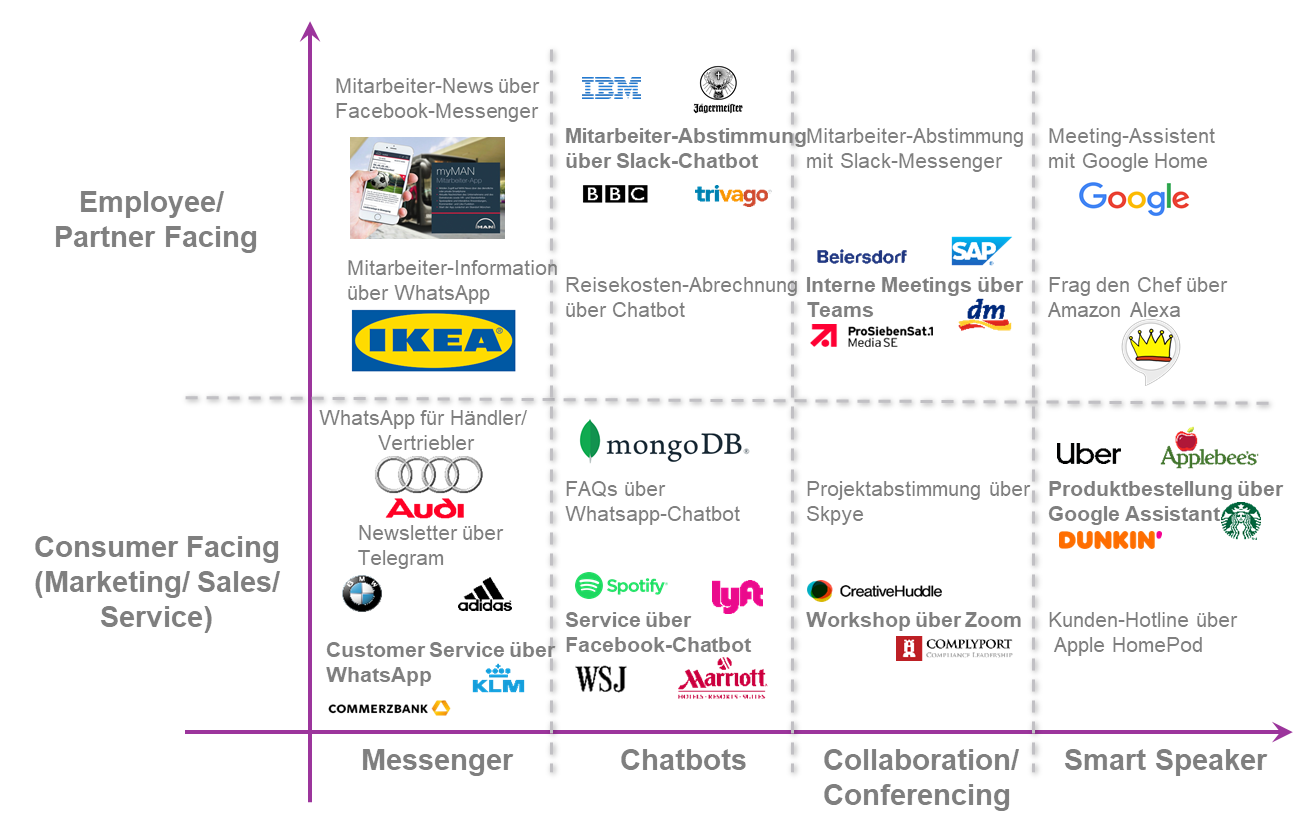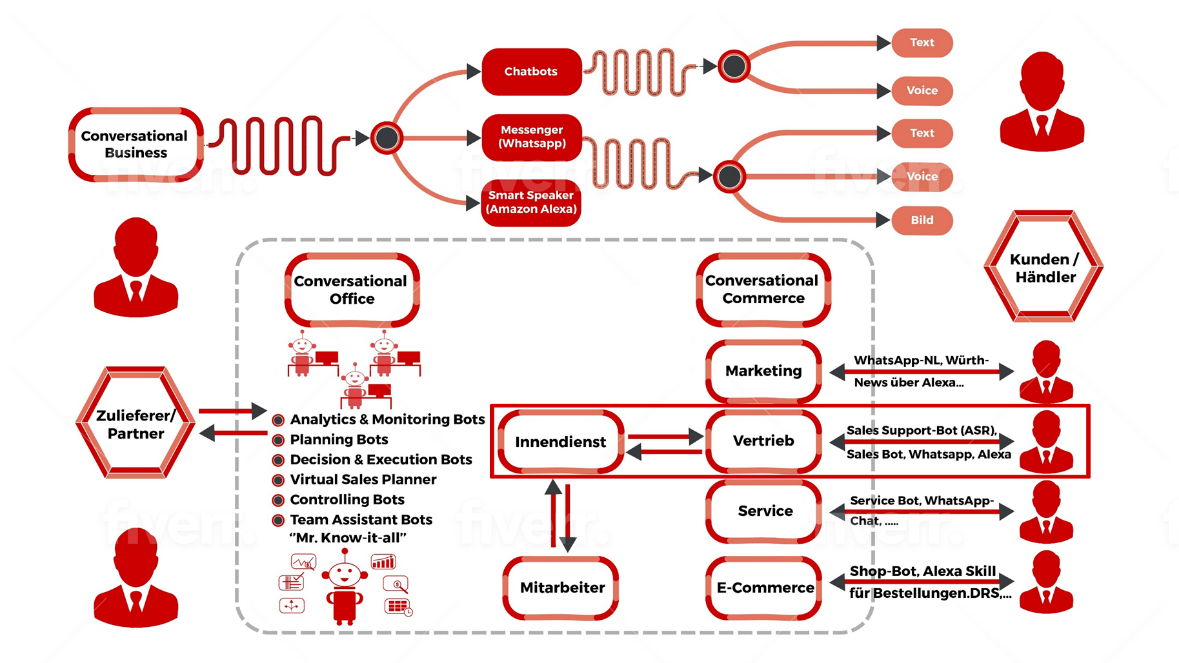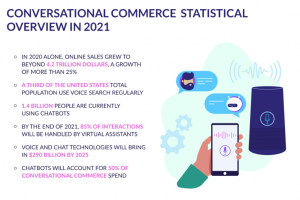Business im Gespräch
- stands for the sum of all digital interaction possibilities of a company that take place with the help of human and non-human support on messaging platforms or smart speaker systems via text-, voice- or video-based dialog.
- is seen as the next big revolution after Web 1.0 and the mobile web. This includes the following communication and interaction systems:
- Messenger (Facebook Messenger, WhatsApp, …)
- Smart Speaker (Amazon Alexa, Google Home, …)
- Active Devices/ Digital Assistants (e.g. Amazon DRS automatically orders printer paper)
- Data and AI-based services (CDP, NLP, NLU, NLG, Speech To Text, ….).
MESSENGER
enable messages to be exchanged between participants in real time (= synchronous communication). Compared to e-mail, messages do not have to be retrieved first, but appear immediately on the other person’s screen and can also be answered by them immediately. In addition to text messages, you can also send all kinds of files (photos, video and audio files, Word documents, etc.).
(CHAT)BOT
refers to a digital dialog system with which users can communicate by entering text or speech. It is composed of the words “chat” (conversation) and “robot” (robot) or the abbreviation “bot”. From this acronym we can deduce that the general function of a (chat)bot is to simulate human communication with digital systems.
ZUSAMMENARBEIT/KONFERENZEN
enable real-time sharing of individual applications or web-based content between two or more computers or mobile devices. Web conferencing platforms can be Internet-based and delivered via Software-as-a-Service (SaaS), or they can run in enterprise data centers (OnPremise). Most web conferencing platforms support voice and video conferencing. Some platforms also support screen annotation, voting, speaker management, chat discussions, shared whiteboards.
SMART SPEAKER SPRACHASSISTENTEN
Voice assistants such as Amazon Alexa or Google Assistant are software solutions that make human speech understandable to machines. Natural Language Processing (NLP) methods are used for this purpose, among others. To use this software, you need terminal equipment. Normally, voice assistants are made available and usable by hardware/smart speakers such as Amazon Alexa or Google Home.
With this definitional understanding, the potential solution space for Conversational Business can be derived. This is shown in Fig. 1 are classified according to the internal/external perspective (employee facing/customer facing) and according to the technical solution approaches messenger, (chat)bot, collaboration/conferencing, smart speaker/voice assistant. In the respective boxes of the matrix, company examples are given for the respective use of Conversational Business.

Fig. 1 Conversational Business solution space
Companies can thus use these technologies for internal and external communication and interaction. Figure 2 shows an example of the various deployment scenarios for Conversational Business.

Fig. 2 Solution space Conversational Business
Conversational Commerce
focuses as part of the Conversational Business on the digital interaction possibilities, which aim at the marketing and sales of products and services.
Conversational commerce describes a young trend in the consumer sector. The term was coined by Chris Messina, who is currently a developer at Uber, and gained currency and acceptance through the hashtag #ConvComm. Basically, the concept is not a new one, as any form of trade traditionally started in conversation. However, in the age of online shopping, conversation has taken a back seat as the large volume of customers cannot be serviced one-on-one and in real time. When buying on the Internet, people therefore increasingly resort to one-way communication in which the customer fills out contact forms or sends e-mails. Direct communication with companies by telephone is often possible, but often involves fees and long queues.
Overall, these forms of contact, which dominate today, are associated with waiting times for the customer and are therefore disadvantageous compared to the classic sales conversation.
Conversational Commerce, on the other hand, provides individualized, two-way, real-time communication with the customer without the need for unrealistic amounts of manpower. The conversation can take place with the help of chatbots, which are either integrated into platforms such as WhatsApp or Facebook Messenger or can be found standalone on the company’s website. In the chat conversations, product advice, sales process, purchase and customer service can be done, making it easier for the customer to consume. Since the customer interacts with the company or the brand in the same way as with a friend, we also speak of the “brand as a friend” concept.
Therefore, companies whose chatbots can have conversations that feel natural and human-like to the user will benefit.
Conversational Commerce enables the optimization of customer interaction through intelligent automation. The overarching goal of conversational commerce is to lead consumers directly from conversation to the purchase of a product or service. These include, for example, the processing of payment transactions, the use of services or even the purchase of
any products. Increasingly, messaging and bot systems are being used to simplify interaction between consumers and companies via voice- and text-based interfaces. This allows the entire customer journey from product evaluation to purchase and service to be optimized through greater efficiency and convenience. In addition to algorithms that control communication via keywords and communication patterns, artificial intelligence is also increasingly being used here to learn from preferences and interactions. This enables the systems to better adapt communication to the situation and also control it proactively.
However, this does not mean automation and real-time messaging at any price; rather, it means systematically examining which touchpoints of the customer journey should be automated and supported by conversational commerce technologies, and how and when, from a cost-benefit perspective.


